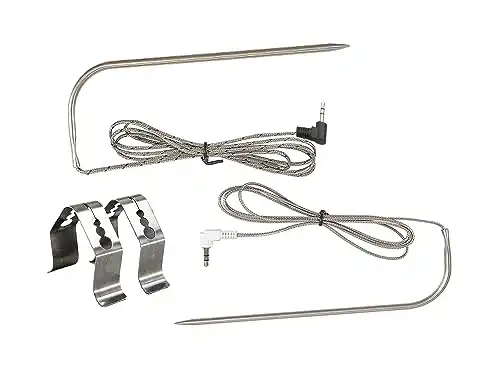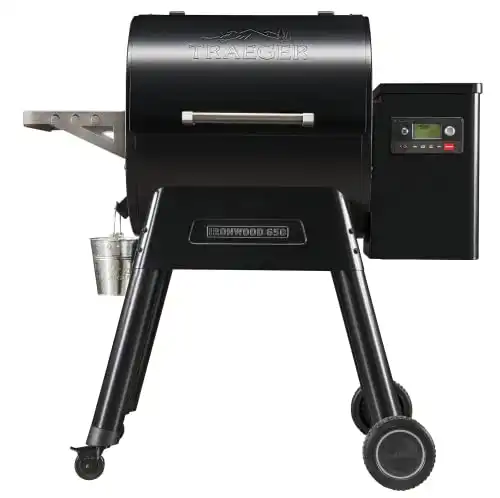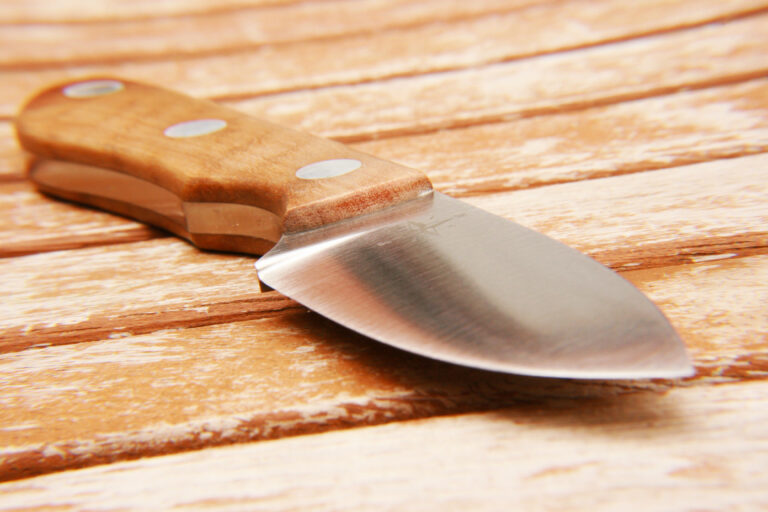5 Steps How to Calibrate Traeger Meat Probe for Perfect Grilling
Calibrate your Traeger meat probe easily for perfect grilling results with this step-by-step guide, ensuring accurate temperature readings for perfectly cooked meats.

Cooking on a grill is a favorite activity for many. Nobody likes their grilled delicacies to be over or undercooked, though. For this article, we’ll discuss how to calibrate the Traeger meat probe to make sure you get the best performance out of your Traeger grill.
Before we get started, it’s worth mentioning that the calibration process is not too difficult and can be completed in a relatively short amount of time. You may sometimes have to re-calibrate your grill and its accessories throughout its life (unlike seasoning). Don’t worry. You’ll be a pro by the end of this article. Let’s get started.
You’ll want to be standing in front of your grill as you follow these instructions. You’ll also need a glass of ice water, so you may want to check that you have a cup of ice available before we start.
Disclosure: As an Amazon Associate, this site earns from qualifying purchases. Thank you!
Wake up your grill
The first thing you’ll want to do is wake up your grill. On the front of all Traeger grills, you’ll find a digital screen with a few buttons and/or knobs. This is the control panel for your grill. Similar to the controls on a range/oven, you’ll be able to monitor temperature, control pellet distribution, and plan your cooking timeframes.
To wake up your grill, push a button on the control panel. There may or may not be a designated button for waking up the grill. You should be able to push any button to bring it to life.
Plug in the Traeger probe jack
You should also see a plug jack on the control panel’s face. Your meat probe will have one end for insertion into the meat and the other end of the wire should have the plug to connect the temperature probe with the control panel. Plug in your probe.
Use the menu
Within the digital display, you’ll see a heading labeled menu. You’ll also notice there is a knob next to the digital screen. The knob is how you’ll scroll up and down. You’ll also push this knob to make your selections. Using the knob on the display area control panel, scroll down to the menu and push the scroll knob to select the menu.
Grill settings
Once you’ve clicked on the menu, you’ll be sent to a second screen. Look for the settings heading and click it. In settings, you’ll see different adjustment and calibration options for your grill. Look for the heading labeled probe calibration and choose it by pushing the scroll knob again.
Probe offset feature
Let’s talk about a fine-tuning feature for the Traeger grills for a second. If you have already calibrated your meat probe, but still need to dial in the temperature settings by a few degrees, probe offset will allow this adjustment. Probe offset allows the user to add or subtract a few degrees for your temperature calibration. Precision adjustments like these are just a few of the great features in Traeger grills.
Calibrate using ice water
Calibration for any measurement tool or machinery requires a base number or condition, considered a standard, on which to work. For temperature calibrations, the freezing point is usually where you’ll start. This temperature, 32 Fahrenheit/0 Celsius, is recognized all over the world and can be achieved and maintained with minimal effort.
Remember that glass of ice water we talked about earlier? You’ll need it now. If you haven’t already gathered these parts, you’ll need a 12oz or greater drinking glass, filled with ice and water. Let the ice water sit for a few minutes so it gets properly cold.
The ice water should stay a consistent 32 degrees Fahrenheit for the calibration process, which is your calibration base temperature. Double-check the temperature of the ice water with a standard, non-electronic, meat thermometer to make sure it’s staying consistent.
Insert and calibrate
Place the meat probe in the ice water/ice bath. Then, on the control panel, click calibrate and let the Traeger grill do its thing. After a few minutes, you should see a reading on your control panel screen indicating the temperature the meat probe is registering.
If the temperature is off a few degrees, use the probe offset feature to dial in your temperature to an exact measurement. Now that the calibration process is complete, you’ll have a running diagnostic center checking the temperature of the meat as well as the grill. This grill management takes the guesswork away and allows for perfectly prepared grill food.
What makes Traeger grills unique?
For most consumers, grilling either consists of using charcoal or propane gas. Both options are widely available, very popular, and work great for grilling. For most, their choice is personal preference, often based on taste or cooking time. These cooking mediums can have drawbacks, though. Charcoal is a classic choice and gives food an undeniable smokey flavor. Charcoal isn’t too expensive, either.
More recently, though, people have moved away from charcoal because of the potential of carcinogens related to charcoal smoke. If charcoal isn’t for you, propane gas is the likely alternative. Propane is clean-burning and can be more consistent in temperature and cooking time than charcoal. Propane is also easier to light and start the cooking process.
Just the same, some grill masters feel propane is too clean and you lose the flavor and smoke ring associated with cooking meat with charcoal. Sensing that there was a market for a third alternative, the use of wood pellets in grilling became a focus for Traeger. First developed over 30 years ago, Traeger has become the industry leader in wood pellet grill technology.
With current models, pellet delivery and heat regulation have been perfected, allowing you to operate your grill much like you would an oven. You’ll be able to set a temperature on your grill and the grill will automatically feed the proper amount of pellets to keep your fire at a consistent temperature.
Whether slow cooking or firing over high heat, Traeger grills can fit your needs. Traeger wood-fired grills use real hardwood pellets to provide optimal and adjustable heat, perfect for whatever you’re cooking. Plus, by using hardwood pellets, your grill food can garner the grill flavoring so many people love.
What Is A Meat Probe?
Whether you’ve recently purchased a Traeger grill, or have been a loyal fan for years, you’ll recognize the quality and craftsmanship in their products. For today, we’ll be focusing on calibrating the meat probe for your grill. For those who may be unsure, a meat probe is a thermometer that is inserted into the meat you’re cooking to determine an internal temperature. This kind of measuring is necessary for properly cooking different cuts or types of meat to their ideal finish.
Especially for chefs who are slow-cooking or smoking a large cut of meat, temperature, and timing are key to perfect results. Too long and the meat is dry or tough. Not long enough and there is a risk of ending up with raw meat and bacteria. Nobody likes these options. With Traeger’s meat probe calibration system, you’ll be able to precisely determine the internal temperature of your food, so you can prepare and present your food with confidence.
WiFIRE technology
Thermometer calibration and grill settings are just some of the ways Traeger grills help backyard chefs, as well as professional grill masters, to produce perfectly cooked or smoked meats. For even greater control, take a look at the WiFIRE technology Traeger offers their customers.
By connecting your phone or mobile device with the Traeger app, you’ll be able to check the temperature and adjust settings from anywhere. No longer are you tied to a hot grill all afternoon. Set your temperature and off you go.
The Traeger community
In addition to producing top-quality grills, Traeger is an excellent source of information for all things grilling and smoking. Browse pro tips, shop for grilling accessories, or discover delicious recipes on their homepage. You can even sign up for online classes to get the most out of your Traeger grill experience. Take a look for yourself at www.traeger.com.
Frequently Asked Questions
How to calibrate Traeger probe?
To calibrate your Traeger probe, you will need a pot of water set to boiling. Place the probe in the water and wait until it beeps. At this point, the reading on the screen should be 212 degrees Fahrenheit. If it is not, you can adjust the temperature on your Traeger accordingly.
Are Traeger meat probes accurate?
Traeger meat probes can be accurate if they are functioning correctly. Typically, a properly working Traeger meat probe will provide a temperature reading that is within 7.5°F of the actual temperature. If you own a D2 WiFIRE grill and want to ensure accuracy, it is recommended to calibrate your probe.
Can I leave the probe in meat while smoking Traeger?
The Traeger meat probe is designed to be left in the meat while smoking, allowing it to accurately monitor the internal temperature on the grill’s LED display without the need to open the lid.
What is the limit on Traeger probes?
The limit on Traeger probes is to not exceed the internal sensor limits of 212°F (100°C) or the ambient sensor limits of 527°F (275°C). If temperatures go beyond these maximums, it may cause damage to the probe.
Why is my Traeger showing wrong temperature?
The Traeger may be showing the wrong temperature due to low-quality or old pellets, which is the primary reason for temperature management issues. To address this, you can check the pellets at the end of the auger or in the firepot. Ensure that they have a nice sheen and a satisfying “snap” when breaking. If the pellets crumble or appear dull, it is advisable to try using a new bag of pellets.
Can you leave probe in meat on Traeger?
The probe can be left in the meat on a Traeger, as it is designed for monitoring the temperature without the need to open the lid.
What to do when low temp detected Traeger?
When a low temperature is detected on a Traeger, you should start by checking the grill’s firmware to ensure it is up to date. Make sure the grill has cooled down and completed its shutdown cycle. Verify that there are enough pellets in the hopper. To further investigate, open the grill and remove the grates, drip tray, and manifold to inspect the firepot.
Why is my Traeger meat probe not working?
Your Traeger meat probe may not be working due to various reasons. To troubleshoot the issue, you should first check if your grill’s firmware is up to date. Ensure that you unplug the meat probe and then plug it back in. It is important to make sure that the meat probe is fully inserted, with the jack flush with the port. Once properly inserted, the grill will emit a beep, indicating that the probe has been successfully connected.
Can you leave the meat temperature stick in the meat for Traeger?
The meat temperature stick can be left in the meat for Traeger, as it is designed for continuous monitoring of the temperature without the need to open the lid.
How do you probe a brisket on a Traeger?
To probe a brisket on a Traeger, start by placing the brisket directly on the grill grate. Then, carefully insert a temperature probe into the center of the flat, ensuring it goes about ½” deep.
Why is my Traeger temperature so high?
Your Traeger temperature may be excessively high if the heat baffle or drip tray is missing or significantly damaged. Severe damage would involve holes that are rusted or burnt through these components. However, it’s important to note that general wear and tear, like minor discoloration or warping, would not cause such issues.
Why is my Traeger temperature reading higher than the setting?
The Traeger temperature reading is higher than the setting due to the main culprit of running hotter being grease buildup, so it is crucial to pay special attention to it.










